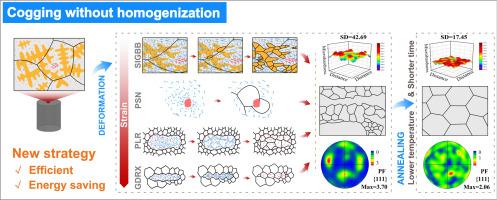A novel strategy for ingot cogging without homogenization: Dynamical recrystallization and nucleation mechanisms associated with as-cast dendrites of nickel-based superalloys
IF 11.2
1区 材料科学
Q1 MATERIALS SCIENCE, MULTIDISCIPLINARY
引用次数: 0
Abstract
Since the as-cast microstructure benefits dynamic recrystallization (DRX) nucleation, the present research is focused on the microstructure evolution associated with the dendrites and precipitates during the thermal deformation of an ingot without homogenization treatment aiming at exploring a new efficient strategy of ingot cogging for superalloys. The as-cast samples were deformed at the sub-solvus temperature, and the DRX evolution from dendritic arms (DAs) to inter-dendritic regions (IDRs) was discussed based on the observation of the fishnet-like DRX microstructures and the gradient of DRX grain size at IDRs. The difference in the precipitates at DAs and IDRs played an essential role during the deformation and DRX process, which finally resulted in very different microstructures in the two areas. A selective strain-induced grain boundary bulging (SIGBB) mechanism was found to function well and dominate the DRX nucleation at DAs. The grain boundary was able to migrate and bulge to nucleate on the condition that the boundary was located at DAs and had a great difference in dislocation density between its opposite sides at the same time. As for DRX nucleation at IDRs, the particle-stimulated nucleation (PSN) mechanism played a leading role, and the progressive subgrain rotation (PSR) and geometric DRX were two important supplementary mechanisms. The dislocation accumulation around the coarse precipitates at IDR resulted in progressive orientation rotation, which would generate DRX nuclei once the maximum misorientation there was sufficient to form a high-angle boundary with the matrix. The PSR or geometric DRX functioned at the severely elongated IDRs at the later stage of deformation, depending on the thickness of the elongated IDRs. The uniform microstructure was obtained by the deformation without homogenization and the subsequent annealing treatment. The smaller strain, the lower annealing temperature, and the much shorter soaking time requested in the above process lead to a smaller risk of cracking and a lower consumption of energy during the ingot-cogging process.

无均质化铸锭轧制的新策略:镍基超级合金的动态再结晶和与铸态枝晶相关的成核机制
由于铸锭微观结构有利于动态再结晶(DRX)成核,本研究重点关注铸锭热变形过程中树枝状晶和沉淀物的微观结构演变,旨在探索超合金铸锭的新有效策略。在亚溶解温度下对铸态样品进行变形,并根据对鱼网状 DRX 微结构和 IDR 处 DRX 晶粒大小梯度的观察,讨论了 DRX 从树枝状臂(DA)到树枝状区域(IDR)的演变过程。在变形和 DRX 过程中,DAs 和 IDRs 处沉淀物的差异起到了至关重要的作用,最终导致这两个区域的微观结构截然不同。研究发现,选择性应变诱导晶界隆起(SIGBB)机制运行良好,主导了 DAs 处的 DRX 成核。晶界能够迁移并隆起成核的条件是晶界位于DAs处,且其相对两侧的位错密度同时存在巨大差异。至于IDR处的DRX成核,粒子刺激成核(PSN)机制起主导作用,渐进亚晶粒旋转(PSR)和几何DRX是两个重要的辅助机制。IDR 处粗析出物周围的位错累积导致了渐进取向旋转,一旦该处的最大取向偏差足以与基体形成高角度边界,就会产生 DRX 核。在变形的后期阶段,PSR 或几何 DRX 在严重拉长的 IDR 上发挥作用,具体取决于拉长 IDR 的厚度。均匀的微观结构是通过不均匀化的变形和随后的退火处理获得的。上述工艺所需的较小应变、较低的退火温度和较短的浸泡时间使得铸锭过程中出现裂纹的风险更小,能耗更低。
本文章由计算机程序翻译,如有差异,请以英文原文为准。
求助全文
约1分钟内获得全文
求助全文
来源期刊

Journal of Materials Science & Technology
工程技术-材料科学:综合
CiteScore
20.00
自引率
11.00%
发文量
995
审稿时长
13 days
期刊介绍:
Journal of Materials Science & Technology strives to promote global collaboration in the field of materials science and technology. It primarily publishes original research papers, invited review articles, letters, research notes, and summaries of scientific achievements. The journal covers a wide range of materials science and technology topics, including metallic materials, inorganic nonmetallic materials, and composite materials.
 求助内容:
求助内容: 应助结果提醒方式:
应助结果提醒方式:


